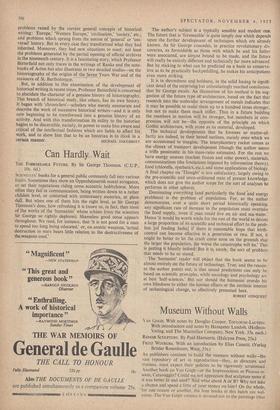Museum Without Walls
VAN GOGH. With notes by Douglas Cooper. TOULOUSE-LAUTREC:.
With introduction and notes by Hanspeter Landolt. (Holbein- With introduction and notes by Hanspeter Landolt. (Holbein-
FRITZ WOTRUBA. With an introduction by Elias Canetti. (Verlag Brtider Rosenbaum, Wien, 35s.) As publishers continue to build the museum without walls—the vast repository of art in reproduction—they, as directors and trustees, must expect their policies to be rigorously scrutinised. Another book on Van Gogh—or the Impressidnists or Picasso or. soon, Caravaggio? Could we not appreciate that sculpture more if it was better lit and sited? And what about A or B? Why not take a chance and spend a little of your money on him? On the whole, for one reason or another, the four books in this batch are wel- come. The Van Gogh volume is devoted not to the paintings (that
would be by now almost an imposition), but to the drawings, thirty-two of them excellently reproduced in colour. No artist offers an easier subject for a book, for his extensive correspondence can provide an easy, readable and illuminating commentary upon the pictures. Mr. Cooper has attached large quotations to a sequence of drawings skilfully chosen to illustrate the 'painter's development, but his personal comments are not very searching. The interest in Toulouse-Lautrec has yet to be exploited as thoroughly as might have been expected and the volume in the same series also devoted to drawings and sketches is even more useful. The introduction and notes by Hanspeter Landolt are both good examples of these difficult forms and seldom fall into either platitudinous generalisation or irrelevance. There is indeed no element in the complexity of the painter's career, the world in which he involved himself and his subtle attitude towards it, his behaviour and psychology, his exceptional facility as a draughts- man, his connections with the art which was to follow, which he does not usefully and intelligently consider.
The two books on sculpture, however, are even more desirable and timely, though both have their shortcomings. The recent acquisition of two of Renoir's bronzes by the Tate Gallery has reminded many people of that interesting aspect of his work, interesting apart from their splendid merits, because contrary to twentieth-century prejudices they depended so much upon the work of another man. Through Vollard's encouragement, a young student of Maillol, Richard Guino, lent his hands and his sculptural experience to the painter who was attracted to this other medium but who was stricken with paralysis. The works which came from this collabora- tion, were adapted from the artist's paintings, and the greatest tribute that could be paid to Guino's skill and sympathy is to say that in every important sense they express in three dimensions Renoir's own sympathies and formal mastery. It is difficult to tell how good were the photographs from which the half-tone blocks have been made, for neither the blocks nor the printing is satis- factory. Also the book has been presented in a crudely elaborate way and M. Haesaerts's decent but unremarkable text has not always been well translated. The Austrian artist Wotruba, now forty-eight, is a sculptor of exceptional power and seriousness, but again the reproductions do not do his work justice. His simple figures, which mix and form the associations of monoliths with the movements and gestures of the human body more eloquently than Moore has linked human and landscape structures, require a
photographic treatment which is both precise and suggestive. Again the photographs may have achieved this, but if so their quality has been obscured by a particularly woolly photogravure. The text, by the novelist Canetti, is sympathetic both to the form and to the associations of the work, but the book does lack a
groundwork of solid information. BASIL TAYLOR











































 Previous page
Previous page